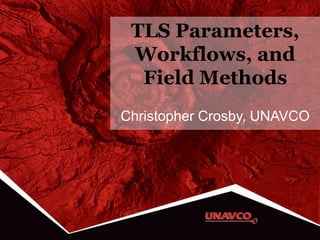
Introduction to TLS Workflow Presentation
- 1. TLS Parameters, Workflows, and Field Methods Christopher Crosby, UNAVCO
- 3. • Transmits laser signals and measures the reflected light to create 3D point clouds. • Wavelength is usually in the infrared (~1550nm) or green (532nm) spectrum How a Lidar Instrument Works
- 4. TLS Instrument and Survey Parameters • Spot size (range, divergence) • Spot spacing (range, angular resolution) • Spot density (range, angle, number of setups) • Angle of incidence (spot shape, intensity, range) • Targets • Edge effects • Registration • First return, last return, “other” • Shadows, field of view • Scan object characteristics (albedo, color, texture) • Area of interest
- 5. Beam Divergence Df = (Divergence * d) + Di @100m, Df = 36mm @500m, Df = 180mm @1000m, Df = 360mm! TLS Instrument and Survey Parameters
- 6. TLS Instrument and Survey Parameters Beam Divergence
- 7. TLS Instrument and Survey Parameters Angular Step Spacing = d(m)*TAN(step)
- 8. Rule of thumb: scan at least 1/10 of the “wavelength” of the object you wish to image. TLS Instrument and Survey Parameters Angular Step
- 9. • Shot spacing varies as a function of range to target. TLS Instrument and Survey Parameters Shot Spacing/Sample Density • Choose angular scan resolution to optimize sample density.
- 10. • Choose scan positions to minimize occluded (shadowed or hidden) geometries. overhang TLS Instrument and Survey Parameters Scan Position
- 11. • Reflective objects that serve as reference points for scans. • Same targets must be common between scan positions. • Use at least 5 reference targets to register scan positions (the more the better). • Different shapes and colors serve different functions (images not to scale) TLS Instrument and Survey Parameters Targets
- 12. Riegl VZ-400 Maximum measurement range as function of target material TLS Instrument and Survey Parameters
- 13. • Spot size (range, divergence) • Spot spacing (range, angular resolution) • Spot density (range, angle, number of setups) • Angle of incidence (spot shape, intensity, range) • Targets • Edge effects • Registration • First return, last return, “other” • Shadows, field of view • Scan object characteristics (albedo, color, texture) • Area of interest TLS Instrument and Survey Parameters
- 14. Before heading out into the field • GPS network – identify base stations, benchmarks, and make sure they are operational! • Understand field site, anticipate challenges you may encounter (complex landscape, is power available in evenings, etc.) • Give equipment a test run. TLS Survey Workflow
- 15. Checklist: • Scanner • Power supply • Laptop • Scanner tripod • Reflector tripods • Flat and cylindrical reflectors • GPS receivers • Safety gear • Permit Basic Field Kit = 300 LBS!
- 16. Will this fit in your vehicle? Who will carry it? Basic Field Kit
- 17. TLS Survey Workflow At the field site • Take a walk around the field site before setting anything up. Identify scan positions, target positions, and your GPS base station. • Set up targets and start GPS data collection. This will take one to two hours. • Only now are you ready to start scanning! • Scan Position 1 • 360-deg Panorama scan + Image acquisition if desired. • Target finescan • Area of interest finescan • Scan Position 2 and beyond • Same as Scan Position 1, but after the target finescan you will find corresponding points with previous scans and co-register scan positions.
- 18. Riegl System Work Flow Overview TLS Survey Workflow
- 19. Capture all of the information you can! • Draw a sketch • Target arrangement? • Scan positions? • GPS locations? • Which targets? Offsets? • Atmospheric conditions • Who are you working with • What are you scanning • Important notes: Professor tripped over the tripod… Metadata
- 20. • Reminders – use at least five targets. That is, every scan position should see at least five targets, every target should be seen by at least two scan positions. • The more targets common to all scan positions, the better. TLS Survey Workflow Standard tie-point workflow
- 21. Geo-referencing
- 22. TLS Survey Workflow Moab, Utah survey site
- 23. Multiple survey positions TLS Survey Workflow Moab, Utah survey site
- 24. Moab, Utah survey site Survey Tie-points TLS Survey Workflow
- 25. • Constellation of thirty-one satellites that each house an atomic clock. • Precise time information is sent to a receiver on Earth. • A minimum of four satellites in sky view is needed to obtain a coordinate. X, Y, Z Global Positioning System
- 26. Uses known reference points (base stations) on the Earth to provide corrections for unknown points. • Advantage is cm to sub-cm precision! • Base station and unknown points must share same occupation time. • Base stations and unknown points must “see” same errors (same sky view). Practical limit is 100km. • Vertical precision will always be ~2x less precise than horizontal precision. Global Positioning System
- 28. Traditional Tie Point Survey Adding GPS to a TLS Survey
- 29. • SOCS – Scanner Own Coordinate System • Each scan position has origin at scanner location • PRCS – PRoject Coordinate System • Local coordinate system for entire project • GLCS – GLobal Coordinate System • ECEF, UTM, State Plane, etc. Adding GPS to a TLS Survey
- 30. • 3D “point cloud” of discrete locations derived from range and orientation of scanner for each laser pulse. • XYZ position in Cartesian coordinates plus associated point attributes: intensity, RGB, etc. • 3D point clouds are the basis for subsequent analysis and used to create CAD or GIS models. Collected Data Point Cloud
- 31. Intensity Range Height True Color Data Visualization
- 32. Data volume can be a problem: • Technology outpaces most software for data processing & management. • Just because you can, doesn’t mean you should • Science application should define data collection. Data Considerations